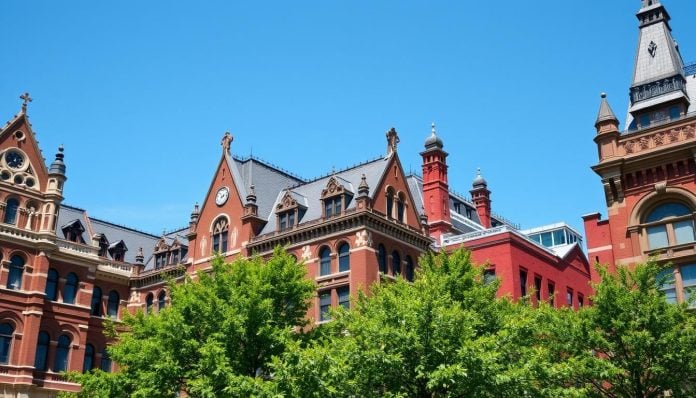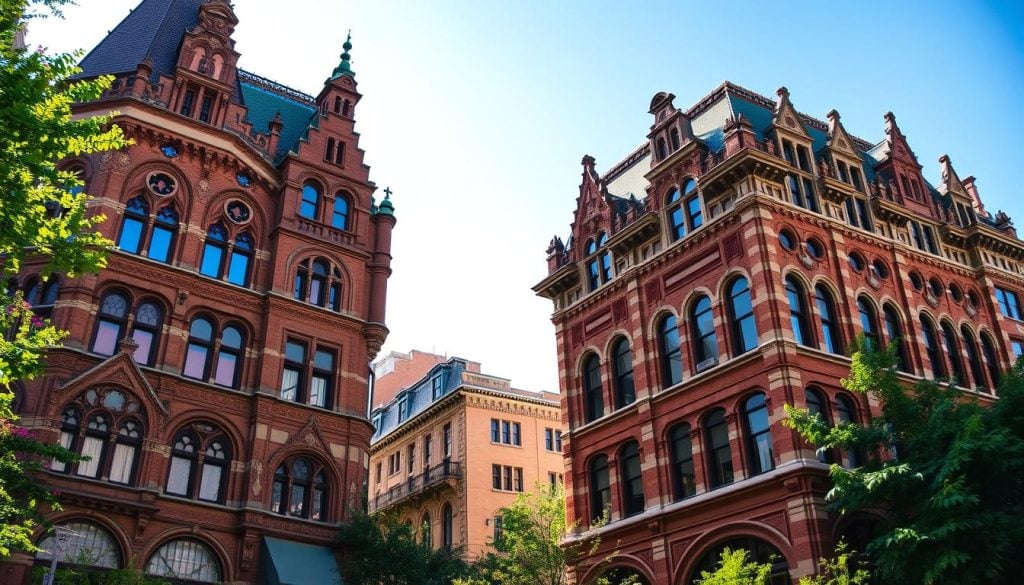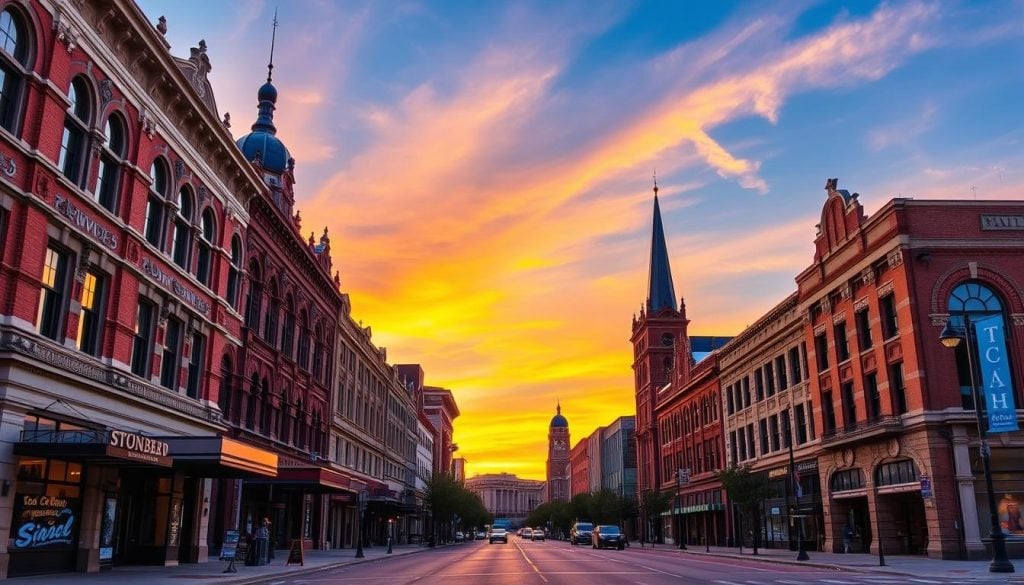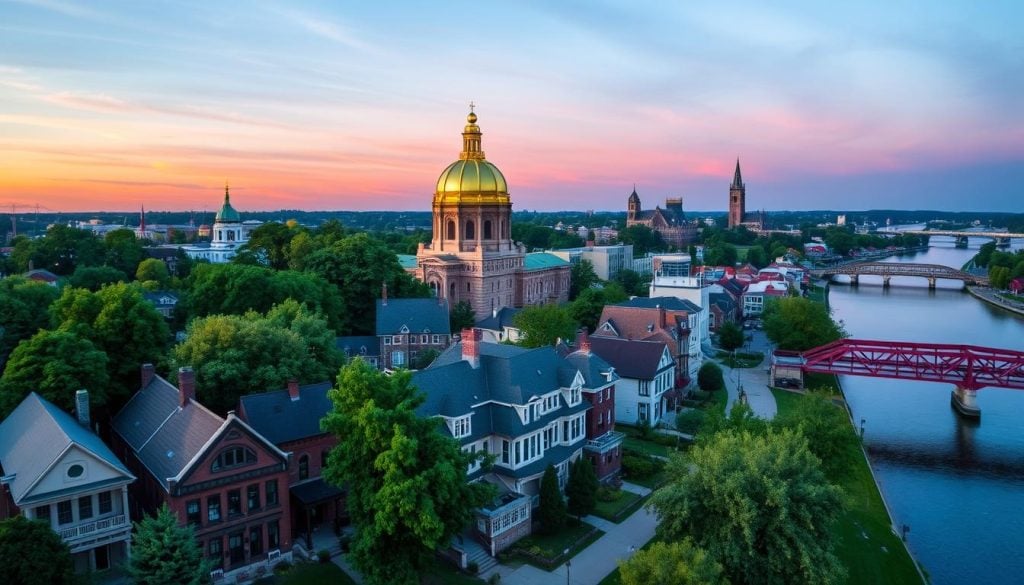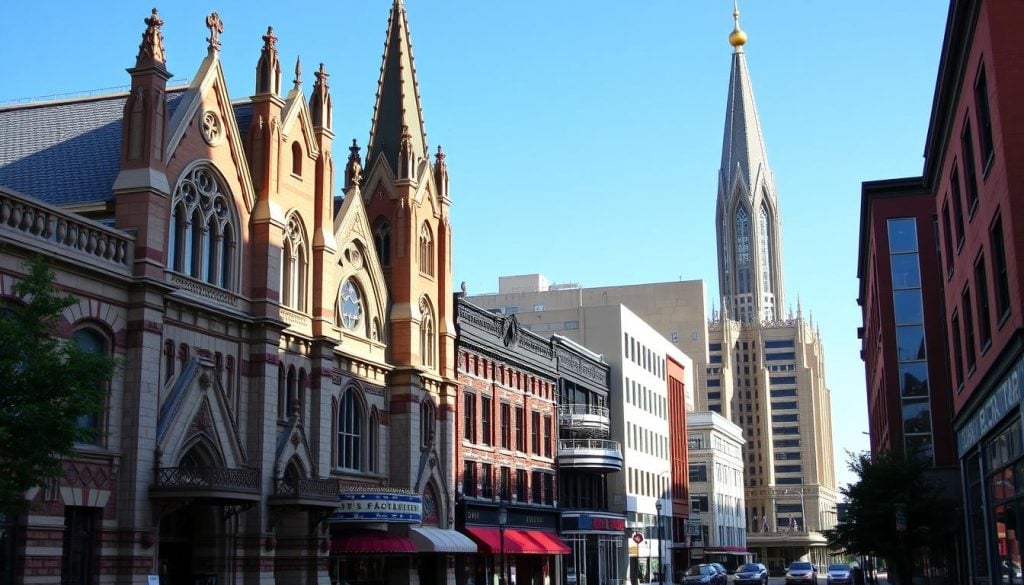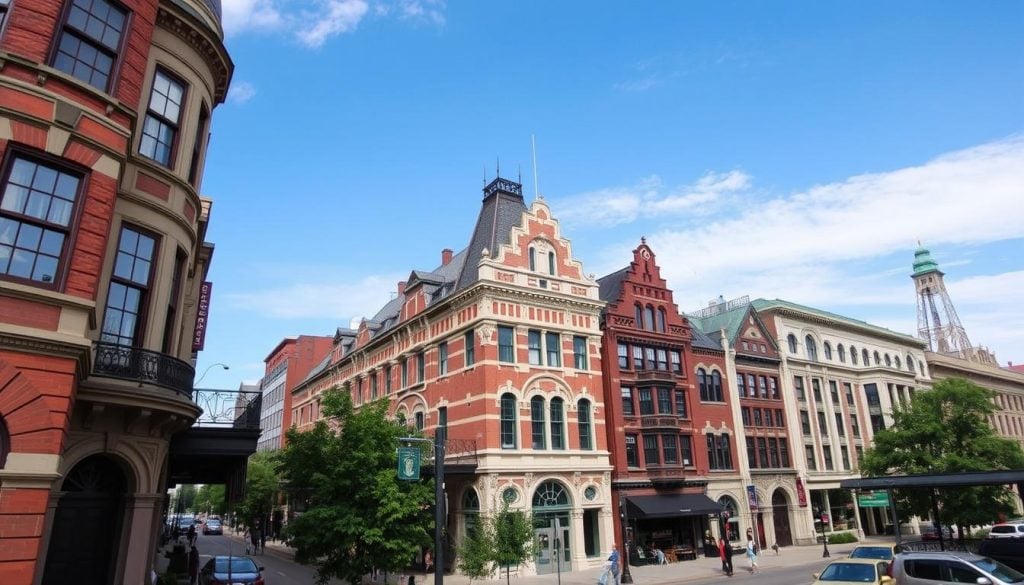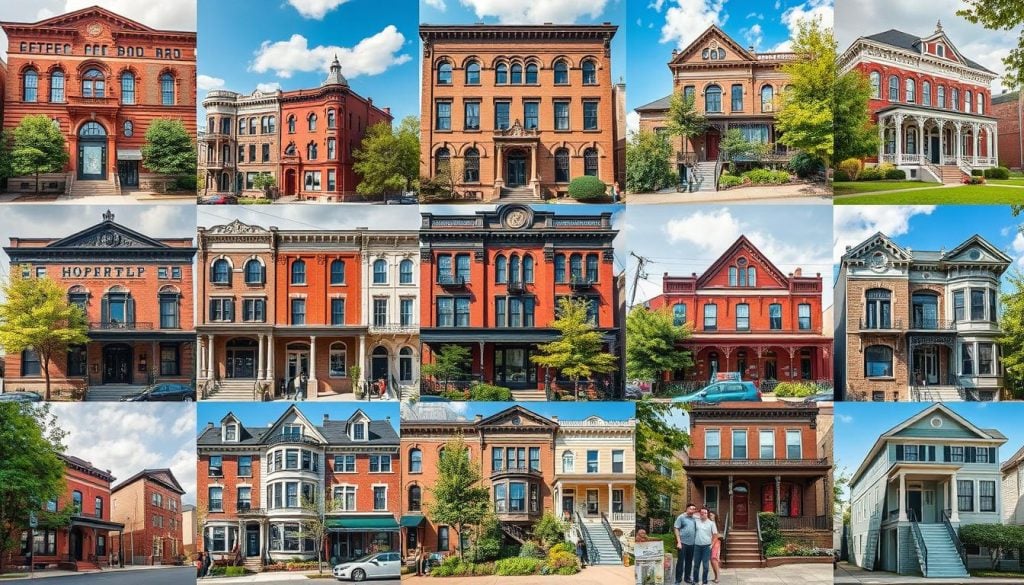Have you ever thought about how a city’s past affects its present and future? South Bend’s architecture shows this link perfectly, with a mix of old and new buildings. These structures tell stories of the city’s growth and culture.
As you look into South Bend’s architecture, you’ll find buildings that are truly iconic. They share the stories of the city’s changes over time. This journey lets you see the beauty and importance of these buildings. It also shows how they’ve shaped the neighborhoods and landmarks of South Bend.
The Rich Architectural Heritage of South Bend
South Bend is a city with a deep architectural heritage. It’s a mix of different cultures, each leaving its mark on the buildings. From the early days, every structure has a story, shaped by economic and social changes. These buildings show the community’s strength and creativity.
South Bend has many historic buildings that tell this story. They are filled with detailed designs that show the time gone by. They also show the hopes and new ideas of their times. As you walk through the city, you’ll see how landmarks show the growth and change of the community.
Today, historic buildings in South Bend are used in new ways. This shows a dedication to keeping the city’s architectural identity while moving forward. It’s a mix of respecting the past and looking to the future. South Bend is a great example of how history can shape and improve cities.
| Architectural Style | Year Established | Notable Features |
|---|---|---|
| Victorian | 1860-1900 | Intricate woodwork, asymmetrical shapes |
| Neoclassical | 1900-1950 | Columns, symmetry, grand staircases |
| Art Deco | 1920-1940 | Geometric designs, bold colors |
| Modernist | 1945-Present | Simplicity, functional form |
The mix of old and new in South Bend’s architecture makes the city special. Every corner has a story to tell. These landmarks add to the city’s rich history, making it more vibrant.
Understanding South Bend Architecture and Historic Buildings
South Bend’s architecture and historic buildings show a mix of styles that tell the city’s story. From the fancy details of the late 19th century to the simple designs of the early 20th century, each time adds its own touch to the city. The use of local materials like brick and limestone shows how the city grew and used what it had.
Looking closer at South Bend’s historic buildings, you’ll see cool features like fancy cornices, big windows, and pretty stonework. These things make the buildings look great and remind us of the skill and care in their making. This skill has helped shape the look of neighborhoods all over the city.
Learning about South Bend’s architecture helps us see how buildings tell the city’s story over time. Each building shares a tale, showing the social, economic, and cultural shifts that shaped South Bend. Keeping these buildings safe is key, so future folks can still feel connected to the past.
| Architectural Feature | Description | Example |
|---|---|---|
| Ornate Cornices | Decorative molding at the top of buildings that enhances visual appeal. | Wilson’s Department Store |
| Limestone Facades | Exterior walls made from local limestone, showcasing durability and beauty. | South Bend City Hall |
| Large Window Frames | Windows designed to maximize natural light and provide a sense of openness. | St. Joseph’s Chapel |
By checking out South Bend’s historic architecture, you learn about the community’s growth and why keeping these places is important for the future.
Notable South Bend Landmarks and Their Stories
Exploring South Bend reveals landmarks that tell the city’s deep history and cultural importance. The Studebaker National Museum is a key spot, showing off a wide range of automotive history linked to South Bend. It tells the story of the famous Studebaker car and the city’s industrial growth.
Significance of the Studebaker National Museum
The Studebaker National Museum is a treasure for history buffs and car lovers. It boasts a collection of classic cars that showcase innovation and skill. Visitors can see the beauty in each car and learn about the company that boosted the local economy for years.
This museum is more than just about cars; it shows the hard work and change of South Bend over time.
Influential Architectural Styles in South Bend
South Bend’s architecture tells a story of change and growth. You’ll see Gothic revival, Italianate, and Prairie styles in many buildings. These styles add beauty and tell of the city’s social and economic changes.
Walking through the city, you’ll see how each building adds to South Bend’s unique identity.
A Journey Through South Bend’s Historic Districts
Exploring South Bend’s historic districts shows a rich mix of culture and history. Each neighborhood has deep roots in important events. They’ve grown from simple trading posts to the lively communities we see now. This journey deepens your love for South Bend’s historical sites across the city.
Exploring Key Neighborhoods
Walking through South Bend’s historic areas, you’ll find these key spots:
- West Washington Street: Known for stunning Victorian homes reflecting architectural elegance.
- Lincoln Park: Features a mix of architectural styles, showcasing the growth of the city.
- East Bank Village: Offers a picturesque view of the river, surrounded by well-preserved historical structures.
The Transition from Trading Posts to Vibrant Communities
The shift from early fur trading posts to thriving neighborhoods is a big part of South Bend’s story. These areas grew to meet a bigger population, boosting the economy. This change is seen in the buildings and streets, adding to the city’s unique feel. By exploring these areas, you get to hear the stories behind each corner, deepening your understanding of the city’s past.
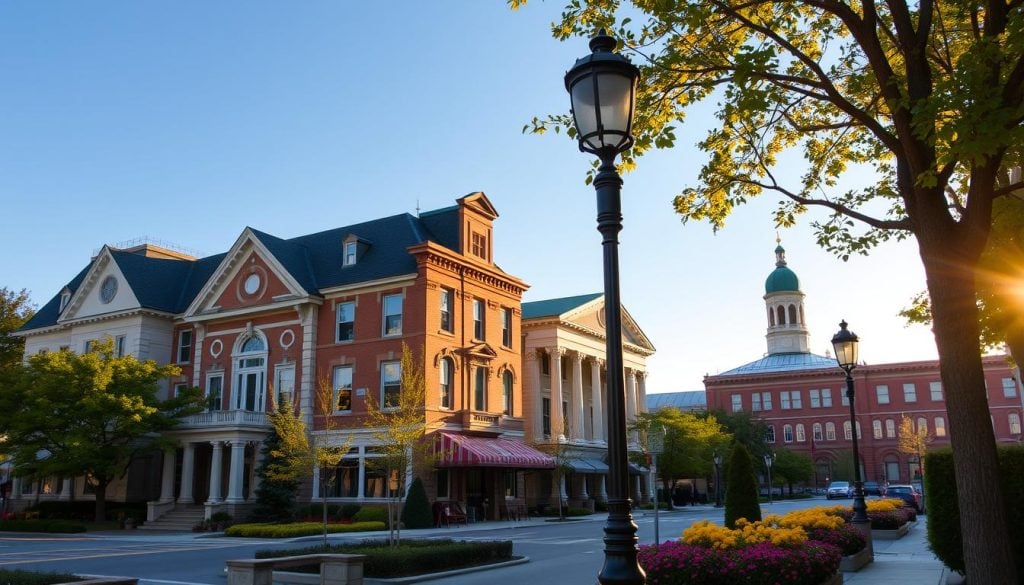
The Influence of Different Architectural Styles
South Bend’s architecture shows a mix of styles that tell of its cultural and historical growth. These styles show how the city has changed over time.
The Gothic Revival style is known for its detailed and tall designs. You can see it in old homes and churches in South Bend. It uses pointed arches and flying buttresses, making buildings look grand and elegant.
Federal architecture is all about symmetry and classic looks. It’s easy to spot its features like fanlights and sidelights on doors. These add to the style’s charm.
Italianate architecture is known for its flat roofs and big windows. It’s seen in many homes and has fancy cornices and bracketed eaves. This style shows the wealth of its time.
South Bend’s mix of architectural styles makes the city look great. It also shows how tastes and values have changed over time. Each style tells us about the community’s dreams, tech progress, and cultural impact.
Here’s a table that lists South Bend’s main architectural styles and what makes them special:
| Architectural Style | Key Characteristics | Notable Examples |
|---|---|---|
| Gothic Revival | Pointed arches, ribbed vaults, vertical lines | St. Joseph County Courthouse |
| Federal | Symmetrical design, decorative entryways | Colfax House |
| Italianate | Flat roofs, tall windows, ornate cornices | Studebaker Mansion |
Exploring the Diverse Range of South Bend Buildings
South Bend offers a unique chance to see the city’s diverse architecture. It shows the rich history and changing identity of the city. You’ll find everything from old wood frame buildings to new takes on classic designs.
Vernacular Wood Frame Structures
The wood frame buildings in South Bend show the area’s architectural spirit. They are simple and practical, showing the city’s history. Built with local materials, they have unique designs that tell stories of the past.
These buildings still charm both locals and visitors. They are a key part of South Bend’s history and culture.
Iconic Adaptations of Old Buildings
South Bend also has old buildings that have been given new life. These buildings keep their history but now serve new purposes. For example, old factories are now trendy apartments, and churches are museums.
This mix of old and new shows South Bend’s commitment to its past and future. It makes the city vibrant and interesting.
| Type of Structure | Characteristics | Significance |
|---|---|---|
| Vernacular Wood Frame | Simple, functional design using local materials | Reflects historical roots and cultural heritage |
| Iconic Adaptations | Repurposed historic buildings with modern functionality | Preserves history while fostering urban growth |
Architectural Tours: A Learning Experience
Exploring South Bend’s architecture is a chance to dive into history, culture, and design. The city offers tours for both locals and visitors. These tours highlight important buildings and add to your understanding of the city’s heritage.
Upcoming Events for Walking Tours
There are many events planned for guided tours this year. Knowledgeable guides lead these walks, sharing stories and facts about South Bend’s buildings. Check local listings for dates and themes that focus on different parts of the city’s history.
Self-Guided Tour Options for Enthusiasts
If you like to explore at your own speed, try self-guided tours. You can download brochures and maps easily. This way, you can enjoy the details of each building at your own pace, making the tour personal to you.
| Tour Type | Description | Duration | Cost |
|---|---|---|---|
| Guided Walking Tour | Explore key landmarks with an expert guide. | 2 hours | $15/person |
| Self-Guided Tour | Discover at your own pace with a downloadable brochure. | Flexible | Free |
| Themed Tours | Focus on specific architectural styles or historical periods. | 1.5 hours | $12/person |
Community Efforts in Preserving South Bend History
Community groups are key in saving South Bend’s history. They work together to protect the buildings that tell the city’s story. Their goal is to keep historical sites safe for the future.
Many groups are working hard to save South Bend’s history. They use campaigns, educational programs, and advocacy. These efforts not only stress the need to save heritage but also build community pride. By fixing up buildings or researching history, they make a big difference in South Bend.
Here are some ways people are preserving South Bend’s architecture:
- They organize events to make people aware of local history.
- They work with city officials to set rules for preserving buildings.
- They encourage everyone to join in on heritage events.
These efforts show how much community members care about South Bend’s unique look. Their hard work proves how much they value the city’s rich history.
Architectural Preservation in South Bend
The journey of preserving architecture in South Bend is complex. It involves balancing new development with keeping history intact. Preservationists face issues like funding, getting people involved, and the need for new infrastructure. As the city grows, debates arise on how to revitalize areas without losing their historic feel. This is key to preserving South Bend’s identity.
Challenges Facing Historic Preservation
One big challenge is the push for new buildings over old ones. People question if fixing up old buildings is worth it financially. Some historic sites can’t get preservation grants because they don’t meet the rules. These problems need creative solutions, teamwork, and more people understanding why saving old buildings is important.
Successful Restoration Projects
Despite the hurdles, South Bend has shown what can be done well in preserving architecture. The Morris Performing Arts Center is a great example of mixing old and new. It’s now a lively spot for events. Another success story is the old South Bend Chocolate Company building, now a modern spot that still feels historic. These projects show that with effort and imagination, South Bend can keep its history alive and vibrant.

































